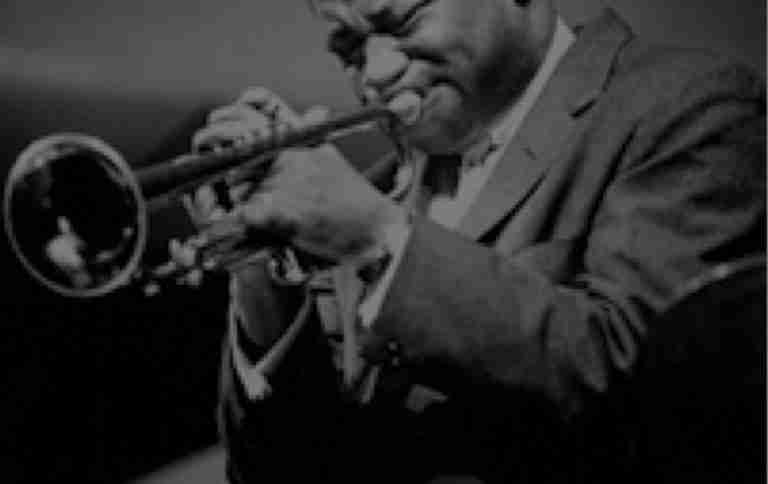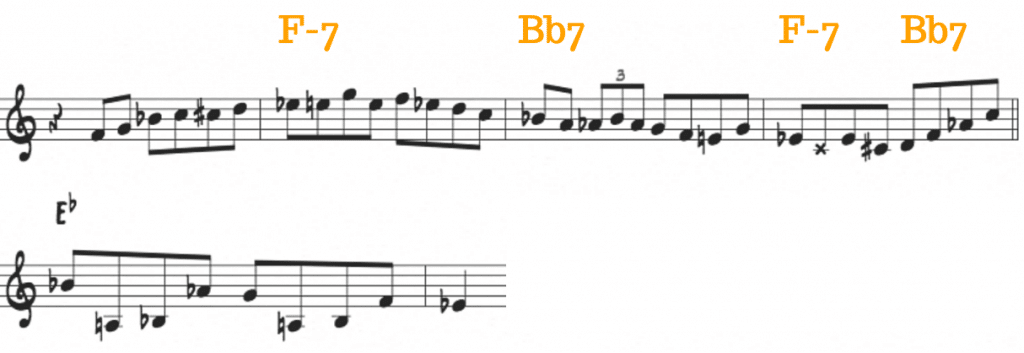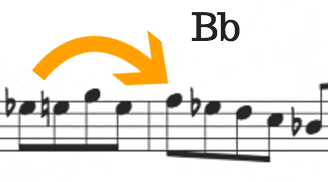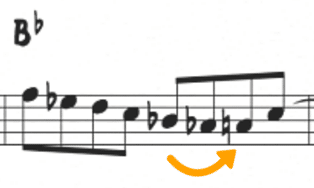Improvising over any chord progression can be a challenge. But the true test of your skills as an improviser comes in those moments when the band drops out and you’re forced to improvise alone, without any accompaniment. The solo break…
All of a sudden the spotlight is on you and you’ve got a split second to come up with a musical line.
What are you going to play?
For some players the answer ends up being a guess and for others, a panicked attempt at throwing in some scales. But there has to be a better way…
Today we’re going to take a look at how a master musician navigates the solo break – Clifford Brown’s solo on After You’ve Gone from the album More Live at the Beehive.
Take a moment and listen to the opening of Clifford’s solo, paying special attention to how he navigates the solo breaks:
The distinctive feature of this particular arrangement is the four bar solo break that happens at the end of every chorus:
Each chorus concludes with a hit in Bb and is followed by a four bar break for the soloist that resolves in Eb Maj7.
Below we’ll show you 4 simple techniques that Clifford Brown uses in his solo to sound great over every solo break…
Solo Break #1: Creating Harmonic Motion with ii-V’s
Clifford opens his solo with the following line:
You hear a long melodic line that stretches over all 4 bars. Musical and masterful. But if you take a closer look, there is more going on here than a line that is simply created on the spot.
Remember, in your solo break you don’t have to reinvent the wheel or create lines out of thin air. You can use the logical motion of established chord progressions (like ii resolving to V) to give your lines a natural harmonic direction.
In this first solo break, Clifford utilizes the concept of implying ii-V’s to create motion in his line:
Rather than trying to make up a line out of thin air, he outlines a one and two bar ii-V progression that creates a logical movement toward the Eb chord.
You can do the same in your own solos! I’m guessing you have some ii-V language or techniques that you use when you improvise. Try implementing these same techniques in your solo breaks as a starting point.
Solo Break #2: Using Blues Language and Chromaticism
One technique that many musicians use to create interest in their solos is playing blues language…
Using notes from the blues scale or creating lines that emphasize the b3, b5, and b7 of a sound.
Check out how Clifford uses this concept to approach his 2nd solo break:
Rather than playing traditional ii-V material or sticking to an established chord progression, he uses blues language in the key of Bb:
By making a blues statement you open up the possibility of playing over a section of the form without feeling tied down to each passing chord.
Try out this technique in your own solos (maybe over the Blues or the A section to Rhythm Changes), playing blues language in the home key rather than thinking about every single chord.
Another technique that Clifford uses in this solo break is combining diatonic lines with chromatic passing tones:
In this line he incorporates chromaticism (Cb) into a Bb Major scale and an A natural and Cb into a Bb Mixolydian scale. This allows him to extend and connect his lines while emphasizing chord tones on strong beats.
Solo Break #3: Extending your lines with enclosures
Perhaps the most challenging part of a solo break is filling up all that empty space with notes…
How do you create a continuous eighth note line?
One technique that Clifford uses to create continuous lines in this solo is by using enclosures. To see what I mean, take a listen to the solo break below:
Enclosures are commonly used to emphasize a specific goal note. Players often use 2 notes (one above, one below) to emphasize a particular note in a line, usually employing a combination of diatonic and chromatic upper and lower neighbors.
In this solo break Clifford uses enclosures in 3 ways…
The 4-note enclosure:
In this line his goal note is the F on beat 1. He encloses this note with 4 approach notes – two chromatic lower neighbors (Eb, E) and a diatonic upper neighbor (G).
This same concept can be applied any chord tone, so learn it in every key!
The 2-note enclosure:
Here the goal note is the A natural on beat 4. He encloses this note with a diatonic upper (Bb) and chromatic lower (Ab) neighbor.
Just like 4-note enclosures, 2-note enclosures are an invaluable tool for every serious improviser.
Creating a string of enclosures:
In this example he uses four enclosures in the space of four measures, utilizing both 4-note and 2-note enclosures to emphasize his goal notes and create a long melodic line.
The overall effect is an enclosure that leads seamlessly into another enclosure. The trick to executing these types of lines is practicing 2 and 4 note enclosures in every key.
By using or adding enclosures to your lines, you can extend the length of your lines and get more mileage out of the language that you already know.
Solo Break #4: Implying Progressions & Substitutions
The final break we’ll look at happens at the start of Clifford’s 4th chorus, check it out:
Here he plays an ascending triadic shape in the first two bars and an altered ii-V in the next two bars.
To create a line like this he is approaching the solo break with a specific chord progression in mind – a I-VI-ii-V7 progression over the first two bars.
By starting with a harmonic blueprint in his mind he can simply connect the dots in his solo rather than creating something from a blank slate.
In this same vein, you could imply Coltrane changes or other turnaround techniques that you’ve learned into a solo break. Or maybe you might even play outside of the written key…
In the next two bars, he resolves the line by playing a ii-V in the key of Eb:
However, instead of the expected Bb7 sound, here he creates harmonic tension by using a whole tone scale that resolves to the Eb Maj7 chord.
So, the next time you encounter a solo break…
Try applying one of these 4 techniques:
- ii-V language
- Blues language & Chromaticism
- 2 and 4-note Enclosures
- Implying Harmonic progression and substitution
With a solid starting point, you will find that you’ll be much more successful at bridging the gap as opposed to relying on scales or simply “winging it.”
Above all, remember to make a musical statement. Play with a great sound, solid rhythmic content and have direction to your line.
At the end of the day, you simply need to get from point A to point B. How you get there is entirely up to you…
























